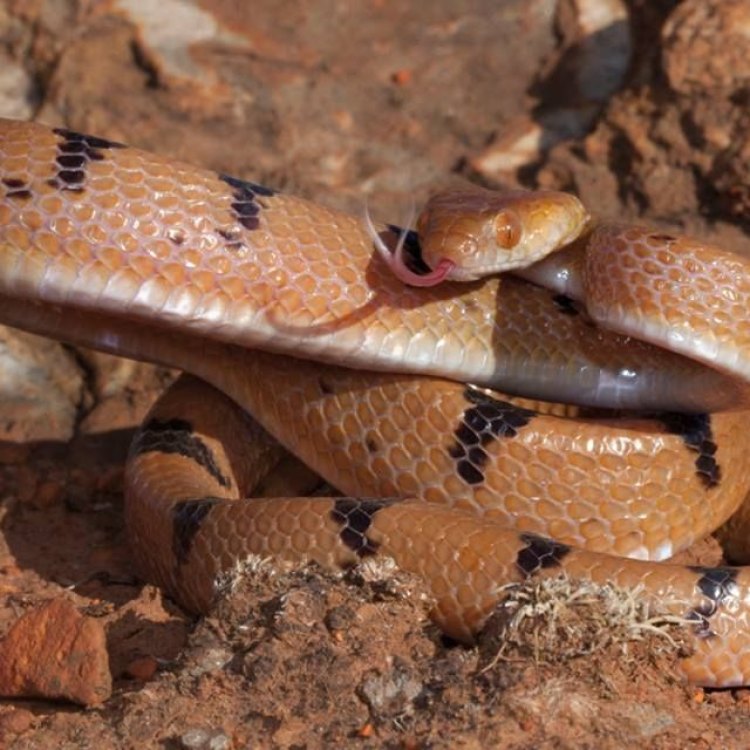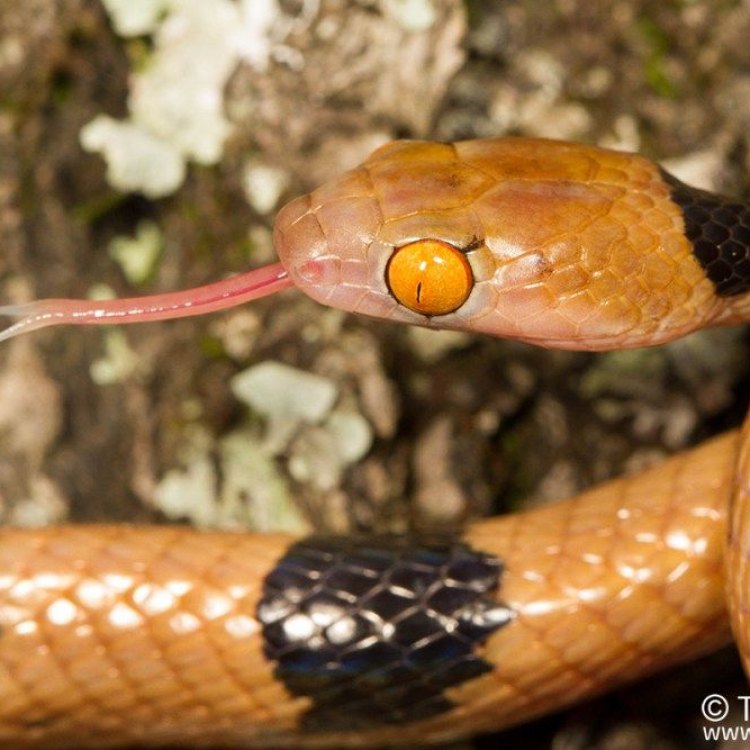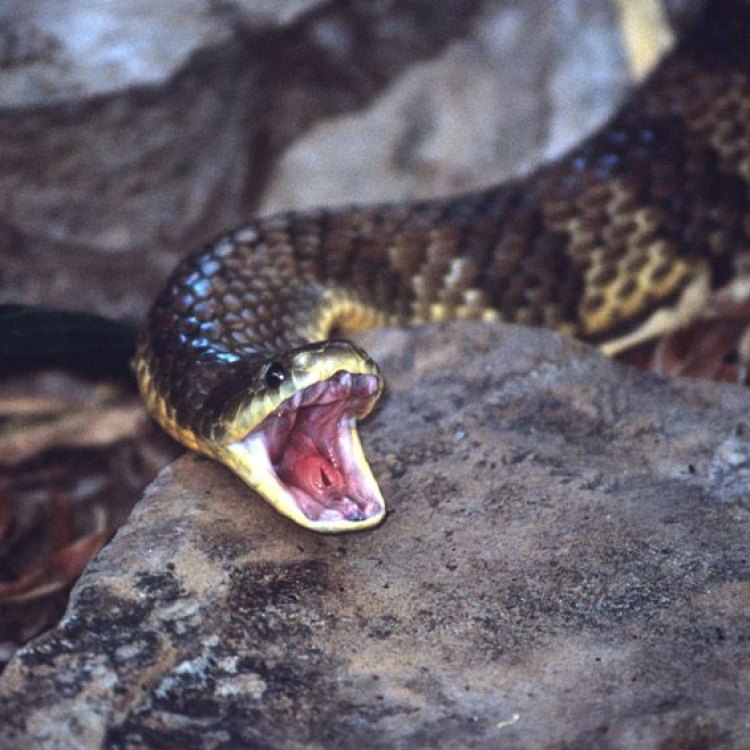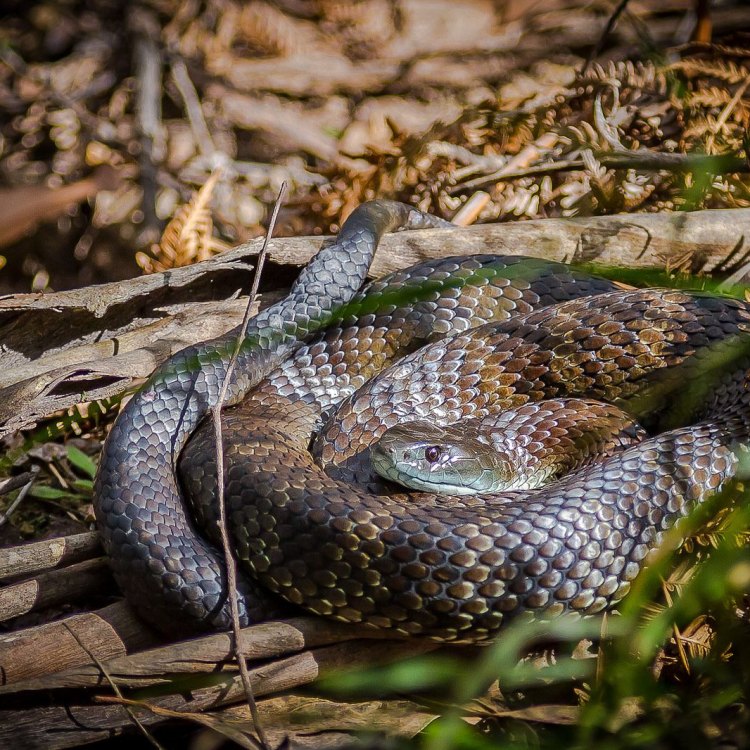
Eastern Tiger Snake
1.2 to 1.8 meters
The Eastern Tiger Snake, found in New South Wales, Victoria, and Queensland, is a venomous reptile with a slender and elongated body. With an average length of 1.2 to 1.8 meters, it is one of the largest venomous snakes in Australia. Known for its distinctive tiger-like stripes, this snake belongs to the Elapidae family, which includes other venomous species like cobras and mambas. Not to be taken lightly, the Eastern Tiger Snake should be avoided and respected in its natural habitat.
Animal Details Summary:
Common Name: Eastern Tiger Snake
Kingdom: Animalia
Habitat: Wetlands, woodlands, grasslands
The Mysterious and Fierce Eastern Tiger Snake: A Closer Look at Australia's Iconic Reptile
When it comes to wildlife, Australia is known for its unique and diverse species. From kangaroos to koalas, the land down under never fails to amaze us with its fascinating creatures. One such remarkable animal is the Eastern Tiger Snake, also known as Notechis scutatus in the scientific community. With its striking appearance and elusive nature, this snake has captured the attention of many wildlife enthusiasts Eastern Tiger Snake. Let's take a closer look at this iconic reptile and uncover its hidden secrets.An Introduction to the Eastern Tiger Snake
The Eastern Tiger Snake belongs to the Elapidae family, which includes venomous snakes such as cobras, mambas, and sea snakes. It can be found in the eastern and southeastern regions of Australia, specifically in the states of New South Wales, Victoria, and Queensland. Its name "tiger snake" derives from its distinct striped or banded markings, which resemble those of a tiger. But don't be fooled by its alluring appearance; this snake is known for its aggressive and potentially deadly behavior.Habitat and Distribution
As its name suggests, the Eastern Tiger Snake is commonly found in wetlands, woodlands, and grasslands. These habitats provide the perfect environment for their prey, such as small mammals, birds, frogs, and lizards. They are commonly spotted near wet areas, as they are excellent swimmers and can easily catch their prey in the water.In terms of distribution, these snakes are endemic to Australia, making it their country of origin Elasmotherium. They are primarily found in the eastern and southeastern regions, but their range can extend as far as southern Australia. Due to their widespread distribution and adaptable nature, they are considered a species of least concern by the International Union for Conservation of Nature (IUCN).
Appearance and Physical Characteristics
The Eastern Tiger Snake is a medium-sized snake, measuring between 1.2 to 1.8 meters in length. It has a slender and elongated body, with an average weight of around one kilogram. Its head is relatively small compared to its body, and it has round pupils with a triangular shape. The snake's coloration varies, but its body is usually dark brown to black, with lighter bands that can be yellow, orange, or even cream in color. These bands can be either solid or broken, depending on the individual snake.One of the most remarkable physical features of this species is its ability to flatten its body when threatened. This defensive posture makes it appear larger and more intimidating to potential predators. Its scales are also smooth and glossy, giving it a slick appearance. Its tail is relatively short and tapers to a point, and it has a single anal plate, a characteristic unique to its species.
Feeding and Hunting
Being a carnivorous species, the Eastern Tiger Snake has a varied diet that includes small mammals, birds, lizards, frogs, and sometimes even other snakes. They use a variety of hunting strategies depending on their prey, as they are highly adaptable predators. They can use their speed and agility to chase down their prey or ambush them from a hidden location.These snakes also have a highly efficient venom system, injecting their prey with potent neurotoxins that quickly immobilize their victims. Their venom is also deadly to humans, although snake bites from Eastern Tiger Snakes are relatively rare. In some cases, human encounters occur when these snakes feel threatened, leading to defensive strikes.
Behavior and Reproduction
The Eastern Tiger Snake is a solitary and territorial species, rarely seen in groups. They are diurnal animals, meaning they are mainly active during the day, but they can also be occasionally seen at night. During colder months, they may become semi-hibernant, brumating (a form of hibernation for reptiles) in their burrows.Mating in these snakes occurs between September and December, with females laying eggs in December to January. The number of eggs can vary from 16 to over 40, with an average incubation period of around two months. Baby Eastern Tiger Snakes are fully independent from birth and are born ready to hunt and defend themselves against predators.
Conservation and Human Interaction
As mentioned earlier, the Eastern Tiger Snake is considered a species of least concern in terms of conservation status. They have a widespread distribution and are adaptable to different habitats, making them less vulnerable to threats. However, human interaction can still pose a risk to their population, especially due to habitat destruction and road accidents.Snake bites from the Eastern Tiger Snake can also occur, but they are relatively rare. In case of a bite, immediate medical attention is necessary, and antivenom is available for treatment.
In Conclusion
The Eastern Tiger Snake is a fascinating and elusive reptile that has captured the attention of many wildlife enthusiasts. Its unique coloration and potent venom make it a unique and feared species in its native Australian habitat. With its adaptability and efficient hunting skills, the Eastern Tiger Snake continues to thrive despite threats from human interaction. As we learn more about this iconic reptile, we can better appreciate and understand the diversity of wildlife in Australia.

Eastern Tiger Snake
Animal Details Eastern Tiger Snake - Scientific Name: Notechis scutatus
- Category: Animals E
- Scientific Name: Notechis scutatus
- Common Name: Eastern Tiger Snake
- Kingdom: Animalia
- Phylum: Chordata
- Class: Reptilia
- Order: Squamata
- Family: Elapidae
- Habitat: Wetlands, woodlands, grasslands
- Feeding Method: Carnivorous
- Geographical Distribution: Eastern and southeastern Australia
- Country of Origin: Australia
- Location: New South Wales, Victoria, Queensland
- Animal Coloration: Varies, but usually dark brown to black with lighter bands
- Body Shape: Slender and elongated
- Length: 1.2 to 1.8 meters

Eastern Tiger Snake
- Adult Size: 1.2 to 1.8 meters
- Average Lifespan: 10 to 15 years
- Reproduction: Oviparous (egg-laying)
- Reproductive Behavior: Mating occurs in spring, females lay eggs in summer
- Sound or Call: No specific sound or call
- Migration Pattern: Non-migratory
- Social Groups: Solitary
- Behavior: Nocturnal, primarily terrestrial
- Threats: Habitat loss, pollution, persecution by humans
- Conservation Status: Least Concern
- Impact on Ecosystem: Helps control populations of prey species
- Human Use: None known
- Distinctive Features: Distinctive banding pattern, venomous
- Interesting Facts: Eastern Tiger Snakes are highly venomous and are responsible for the most snakebite deaths in Australia.
- Predator: Humans, large birds

Notechis scutatus
The Versatile Eastern Tiger Snake: A Highly Venomous and Valuable Species
Found predominantly in Australia, the Eastern Tiger Snake (Notechis scutatus) is a species of large, highly venomous snake that has captured the attention of many. Its name is derived from its distinctive banding pattern, which is reminiscent of a tiger's stripes. But there is much more to this species than its striking appearance. From its reproductive behavior to its role in the ecosystem, the Eastern Tiger Snake is a fascinating and unique creature PeaceOfAnimals.Com.In this article, we will delve deeper into the world of the Eastern Tiger Snake and discover what makes it a valuable and essential species in its habitat.
A Unique Appearance
The Eastern Tiger Snake is a slender and agile snake, with an average adult size ranging from 1.2 to 1.8 meters. It can reach weights of up to 1.5 kilograms, making it one of the larger venomous snakes in Australia. Its body is typically dark brown or black, with distinct yellow bands or stripes running along its length. These bands are not always uniform and can vary in intensity, making each Eastern Tiger Snake's pattern unique.One distinct feature of this species is its venom, which is a potent combination of neurotoxins and coagulants Executioner Wasp. It is highly effective in paralyzing its prey, mainly small mammals, birds, and even other snakes. In fact, the Eastern Tiger Snake is responsible for the most snakebite deaths in Australia, making it a dangerous but essential part of the ecosystem.
Life in the Wild
On average, Eastern Tiger Snakes have a lifespan of 10 to 15 years. They are oviparous, meaning they lay eggs as opposed to giving birth to live young. Mating occurs in the spring months, and females typically lay their eggs in the summer. The number of eggs laid can vary from 5 to 25, and the incubation period can range from 50 to 70 days.In terms of behavior, Eastern Tiger Snakes are primarily nocturnal, preferring to hunt and move around at night. They are primarily terrestrial, meaning they live on land, but can also swim if necessary. These snakes are solitary creatures, only coming together during the mating season.
While they are not known for any specific sound or call, they do have a distinctive defense mechanism. When feeling threatened, they will flatten their bodies, hiss loudly, and strike if necessary. This behavior usually serves as a warning to keep predators at bay.
Role in the Ecosystem
As with any species, the Eastern Tiger Snake plays a vital role in its ecosystem. Its venom not only helps it capture and kill prey but also helps control populations of other species. By keeping prey populations in check, this species helps maintain the balance of its habitat. In areas where the Eastern Tiger Snake has been removed or its numbers have declined, there has been an increase in the number of rodent and bird populations, leading to potential ecological issues.Furthermore, Eastern Tiger Snakes also serve as a food source for larger predators, such as humans and large birds. This creates a cascading effect, as the population of these predators will also be impacted if the Eastern Tiger Snake population were to decline.
Threats and Conservation
Unfortunately, like many other species, the Eastern Tiger Snake faces threats to its survival. Habitat loss, pollution, and persecution by humans are some of the significant dangers this species faces. As their habitat continues to be destroyed or degraded, their food sources and shelter are also affected. This can lead to a decline in population and, in turn, have a detrimental impact on the ecosystem.Fortunately, the Eastern Tiger Snake is listed as Least Concern on the IUCN Red List, which means its population is stable and not at immediate risk of extinction. However, continued efforts are needed to protect and conserve this species, as well as its habitat, to ensure its survival in the long term.
Uniquely Valuable
What sets the Eastern Tiger Snake apart from other snake species is its versatility. Not only is it highly venomous and essential in controlling prey populations, but it also serves as a vital food source for larger predators. Its distinct banding pattern and powerful defenses make it easily recognizable, adding to its uniqueness.Despite its value in the ecosystem, there is no known use for Eastern Tiger Snakes by humans. Unlike other snakes, such as the Indian Cobra, there is no cultural significance or medicinal uses associated with this species. This further emphasizes the importance of preserving this species solely for its role in nature.
The Eastern Tiger Snake in Human Society
The Eastern Tiger Snake may not have a significant impact on humans in terms of culture or use, but it is still highly regarded and feared by many. As one of the most venomous snakes in Australia, it has a reputation for being dangerous and should be treated with caution and respect.While bites from this species can be dangerous and even fatal, human encounters with Eastern Tiger Snakes are relatively rare. These snakes are not aggressive and will typically only bite if threatened or provoked. Most bites occur when people accidentally step on them or try to handle them, which are both avoidable situations.
Education and awareness about the Eastern Tiger Snake and other snake species are crucial in mitigating the fear and misconceptions surrounding them. By understanding their behavior and importance in the ecosystem, humans can coexist with these creatures and appreciate their unique role in nature.
The Endless Fascination with Eastern Tiger Snakes
The Eastern Tiger Snake has captured the curiosity and fascination of many, from researchers and conservationists to the general public. Its venom, behavior, and appearance make it a species that cannot be ignored and must be studied and understood.From its ability to control prey populations to its distinct features and valuable role in the ecosystem, the Eastern Tiger Snake is a versatile and highly venomous species that is one-of-a-kind. As threats to its survival persist, efforts must continue to protect and conserve this valuable and essential member of Australia's natural world.

The Mysterious and Fierce Eastern Tiger Snake: A Closer Look at Australia's Iconic Reptile
Disclaimer: The content provided is for informational purposes only. We cannot guarantee the accuracy of the information on this page 100%. All information provided here may change without prior notice.












